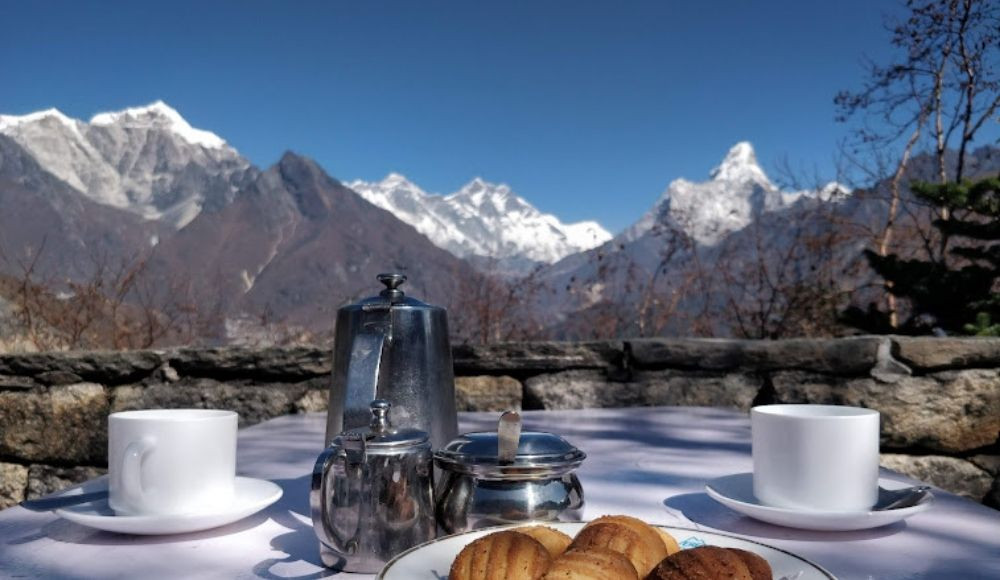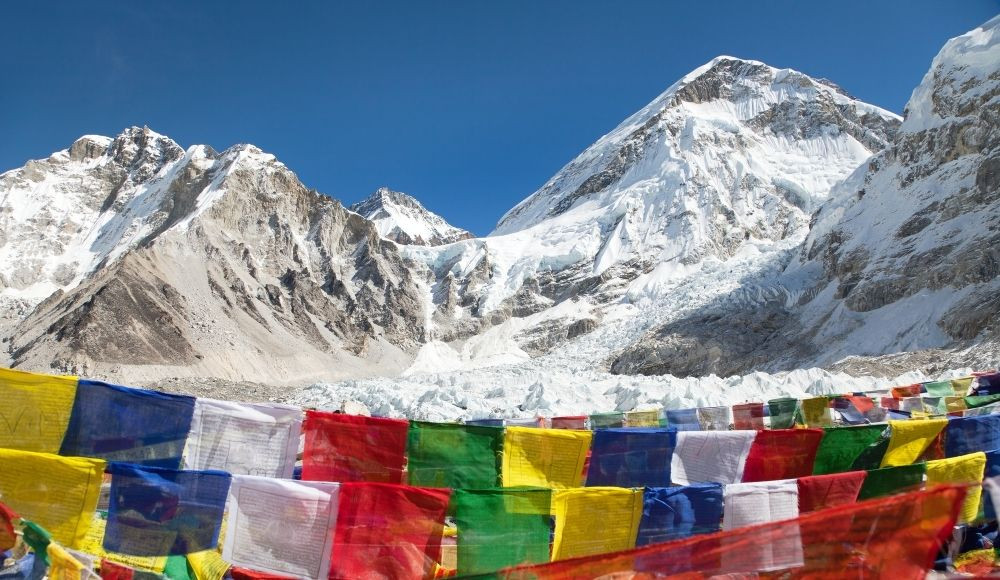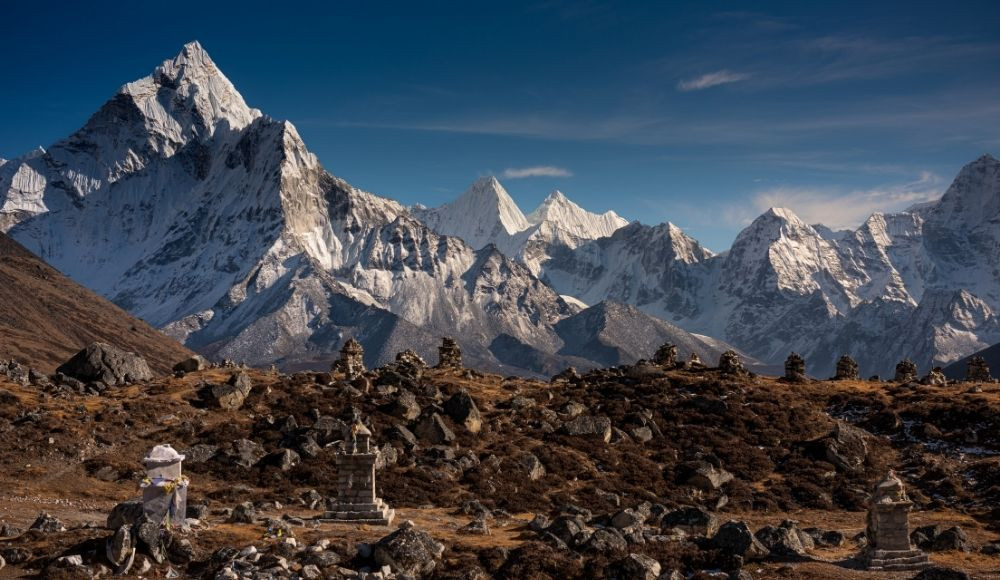Everest Base Camp Luxury Trek
Trip Facts
Trip Highlights
- Breathtaking flight from Kathmandu to Lukla.
- Spectacular 360-degree panoramic views of the mountain ranges.
- Comfortable accommodations at luxury lodges, such as Yeti Mountain Home, Summit Lodge, and Hotel Everest View.
- Better food options with more variety and higher quality than at traditional teahouses.
- Smaller group sizes and experienced guides and support staff for personalized attention.
- Access to modern amenities, such as Wi-Fi and charging facilities for electronic devices.
Trip Overview
The Everest Base Camp Luxury Trek is a more comfortable alternative to the traditional Everest Base Camp trek, offering a higher standard of accommodation, food, and service. This trek typically includes stays in luxury lodges or hotels that provide private rooms with en-suite bathrooms, heated rooms, hot showers, and a range of other amenities. In addition to these comforts, luxury treks often have smaller group sizes and are accompanied by experienced guides and support staff, ensuring personalized attention and assistance throughout the journey. The itinerary for an Everest Base Camp Luxury Trek is usually similar to the standard trek, covering the same route, and taking around 12 to 14 days to complete. The trek begins with a flight from Kathmandu to Lukla, followed by a hike through Sherpa villages, including Phakding, Namche Bazaar, Tengboche, Dingboche, Lobuche, and Gorak Shep, before reaching Everest Base Camp. The trek also includes a hike to Kala Patthar for spectacular views of Mount Everest and surrounding peaks.
Natural beauty is a luxury on this trek; to make your trip even better, you will stay at luxurious accommodations. This Everest base camp luxury trek provides you with an opportunity to experience the Himalayas without compromising your comfort. Facilities such as a clean and comfortable bed with an attached bathroom are luxuries in hard-to-reach places such as the Everest region. Good food, hot showers, internet access, and most importantly clean and comfortable washrooms are the facilities that you will get during the trek. Besides all the lavish amenities you get during the trek, let's not forget about the magnificent beauty that you will witness during your trek. The rough and rugged trail of the Everest region leads to some of the most fascinating and breathtaking views that you will ever come across in your life. You will stand at the base camp of the world's highest mountain along with peaks above 8,000 m in Nepal.
You will gather some of the most beautiful memories and first-hand trekking experiences. You will explore the landscape of the highlands of Nepal followed by locals with unique yet satisfying hospitality and culture. Monasteries, Chortens, old and new villages, stunning vegetation, and majestic animals are all part of this trek. The luxury that this trek provides will just add more essence to this trek and help you take full advantage of the surroundings and thrilling journey of your life.
Everest, Makalu, Lhotse, Cho Oyu, etc. are some of the popular mountains that you can witness from your bedroom during your Everest Luxury Trek. Meanwhile, Kala Patthar is one of the best places to witness jaw-dropping views of the Everest ranges. You can get 360-degree Himalayan views from the Kala Patthar situated at 5,545 meters above sea level.
Meanwhile, during your Everest base camp luxury trek, you get the opportunity to stay at the finest local luxury houses available throughout the trekking route. Experience the typical Himalayan lifestyle as well as the culture and traditions of the local Sherpas. Besides that, you will also get the opportunity to witness the high mountain ranges from your bedroom window. All you have to do is to open the curtain of the window.
Kathmandu City Sightseeing
Kathmandu, the capital city of Nepal, is rich in culture, history, and architectural wonders, making it an ideal destination for sightseeing. The city is home to several UNESCO World Heritage sites and offers a fascinating blend of ancient and modern attractions. Here are some of the top sightseeing spots in Kathmandu:
-
Kathmandu Durbar Square: This historic square is located in the heart of the old city and features palaces, temples, and courtyards built between the 12th and 18th centuries. The square was once the seat of the ancient Malla kings of Kathmandu.
-
Swayambhunath Stupa: Also known as the Monkey Temple, Swayambhunath is one of the most sacred Buddhist sites in Nepal. The stupa sits atop a hill and offers panoramic views of the city. The site is also home to numerous monkeys, giving it its nickname.
-
Boudhanath Stupa: This massive stupa is one of the largest in the world and an important pilgrimage site for Tibetan Buddhists. The stupa is surrounded by monasteries, shops, and restaurants, making it a lively and fascinating place to visit.
-
Pashupatinath Temple: Dedicated to Lord Shiva, Pashupatinath is the most sacred Hindu temple in Nepal. Located on the banks of the Bagmati River, the temple complex is a significant pilgrimage site and features beautiful architecture, ghats, and cremation sites.
-
Thamel: This bustling commercial neighborhood is a popular destination for tourists, offering shops, restaurants, and hotels. Thamel is an excellent place to buy souvenirs, sample Nepali cuisine, or simply explore the vibrant streets.
-
Patan Durbar Square: Located in the nearby city of Patan (also known as Lalitpur), this square is home to beautiful temples, palaces, and courtyards. The Patan Museum, located within the former royal palace, is a must-visit for its collection of traditional Nepali art and artifacts.
-
Bhaktapur Durbar Square: Situated in the ancient city of Bhaktapur, this square boasts well-preserved architecture and impressive monuments. Highlights include the 55-Window Palace, Nyatapola Temple, and the Golden Gate.
While these are just a few of the many attractions in and around Kathmandu, they offer a glimpse of the city's rich history, culture, and architecture.
Sagarmatha National Park
Sagarmatha National Park is a protected area located in the Solukhumbu district of Nepal. Sagarmatha National Park is considered one of the most breathtaking national parks in Nepal, among the twelve spectacular national parks in the country. It was established in 1976 and covers an area of 1,148 square kilometers, including parts of the Himalayas and the Mount Everest region. The park is named after Sagarmatha, the Nepali name for Mount Everest, which is the highest peak in the world. The park is home to several other notable peaks, including Lhotse, Cho Oyu, and Ama Dablam, as well as numerous glaciers, rivers, and valleys. The park is known for its unique flora and fauna, including several rare and endangered species such as the snow leopard, Himalayan black bear, and the red panda. The park is also home to several bird species, including the Himalayan monal, which is the national bird of Nepal.
The park is a popular destination for trekkers and mountaineers, with several trekking routes leading to the Everest Base Camp and other popular destinations in the region. The park also offers several opportunities for adventure tourism, including mountaineering, rock climbing, and whitewater rafting. To enter the park, visitors need to obtain a permit from the Sagarmatha National Park office in Kathmandu or the checkpoint in Monjo. The park has several accommodation options, including lodges and teahouses, which offer basic facilities for trekkers.
Everest Base Camp
The Everest base camp is located at an elevation of 5,364 meters above sea level. It is the ultimate destination for trekkers who are eager to have a close view of Mount Everest, the highest peak in the world. Mount Everest, known as Sagarmatha in Nepali and Chomolungma in Tibetan, has different names in these two languages. In addition to Everest, the Everest Base Camp offers views of several other high peaks. The base camp is the ultimate destination for most of the trekkers visiting the Everest region, as it is one of the most visited mountain base camps. The base camp is surrounded by towering mountains, creating a breathtaking view of the sunrise. You have the opportunity to engage with fellow trekkers and fully appreciate the experience of witnessing the world's highest peak.
Kala Patthar - The vantage point of Everest
Kala Patthar, meaning "Black Rock" in both Nepali and Hindi, is a significant landmark in the Himalayas of Nepal. The small peak is situated on the southern ridge of Pumori, which is a mountain in the Mahalangur range. Pumori stands at an impressive height of 7,161 meters (23,494 feet). Kala Patthar is located opposite Mount Everest's base camp, at an elevation of around 5,644 meters (18,519 feet) above sea level. Although Kala Patthar is not exceptionally tall, it remains a highly sought-after destination for trekkers and mountaineers due to its accessibility and breathtaking views of Mount Everest (8,848 meters/29,029 feet), the tallest mountain on Earth. Additionally, Kala Patthar offers stunning vistas of Lhotse (8,516 meters/27,940 feet) and Nuptse (7,861 meters/25,791 feet). The journey to Kala Patthar is generally regarded as moderately challenging and typically spans 12-14 days, which includes a necessary period for acclimatization to adapt to the high altitude.
Namche Bazaar - The Gateway to Everest
Namche Bazaar is a bustling town and trading hub in the Solu-Khumbu District of Nepal, situated at an altitude of approximately 3,440 meters (11,286 feet) above sea level. It is often referred to as the "Gateway to Everest" because it serves as a key stopover point for trekkers and climbers heading to Mount Everest, other peaks in the region, and Everest Base Camp. Namche Bazaar is the largest settlement in the Khumbu region and a popular acclimatization spot for trekkers due to its altitude. It is common for trekkers to spend at least two nights here to help their bodies adjust to the thinner air at higher elevations.
The town is built on a steep mountain bowl-shaped terrain, which offers stunning views of the surrounding Himalayan peaks. It features a variety of lodges, guesthouses, restaurants, and shops catering to the needs of trekkers and climbers. Additionally, Namche Bazaar has internet cafes, bakeries, a post office, and even a few bars, making it a relatively well-developed and comfortable place to rest and resupply. Every Saturday, a weekly market is held in Namche Bazaar, where traders from lower-lying villages come to sell their goods, and locals and trekkers alike can buy various items, including fresh produce, clothing, trekking gear, and souvenirs. The town also has a few notable sites, such as the Sherpa Culture Museum and the Sagarmatha National Park Visitor's Center, where visitors can learn about the region's culture, history, and environment.
Luxurious Accommodations
While the Everest Base Camp (EBC) trek is primarily known for its teahouses and basic lodges, there are some luxury accommodations available that cater to trekkers seeking a more comfortable experience. These luxury lodges typically offer private rooms with en-suite bathrooms, comfortable beds, heated rooms, hot showers, and a higher standard of food and service compared to traditional teahouses. Wi-Fi and charging facilities for electronic devices are often available as well.
Some of the luxury lodges and accommodations along the Everest Base Camp trek include:
-
Yeti Mountain Home: A chain of luxury lodges located in various places along the EBC trek, including Lukla, Phakding, Monjo, Namche Bazaar, Thame, and Kongde. These lodges offer comfortable rooms, en-suite bathrooms, and panoramic mountain views.
-
Hotel Everest View: Situated at an altitude of 3,880 meters (12,730 feet) near Syangboche airstrip, Hotel Everest View is listed in the Guinness Book of World Records as the highest-placed hotel in the world. It offers stunning views of Mount Everest and a high level of comfort and service.
-
Summit Lodge: Summit Lodge is also a luxury lodge chain located at multiple points along the Everest trek including Monjo, Lukla, Thame, and Pangboche. It offers well-appointed rooms, en-suite bathrooms, and a range of amenities to ensure a comfortable stay.
Keep in mind that luxury accommodations along the Everest Base Camp trek can be limited, and the level of luxury might not be comparable to what you'd find in lower altitude regions or urban areas. It's important to have realistic expectations, as remote high-altitude locations can present logistical challenges.
Best Time for Everest Base Camp Luxury Trek
Everest region is one of the most popular treks of Nepal. Every year thousands of visitors go through this route to witness some of the highest peaks in the world including Mount Everest. It is also an ideal choice to experience the Sherpa culture, traditions as well as food. However, Everest Luxury Trek is not suitable to go throughout the year. During the winter season of the year, the high snowfall blocks the trek route. Because of that it is impossible to trek during these months of the year. Similarly, it is better to avoid the monsoon season of the year too.
The best months for the Everest base camp luxury trek are September, October, and November. During these months of the year, the sky is clear and you can witness some of the gigantic mountains. The chances of rainfall as well as snowfall are also very low which makes it an ideal choice for the trek. Similarly, March, April, and May are also the best months for the Everest base camp luxury trek. You walk through the Rhododendron forest in the lower regions during these months of the year.
Detailed Itinerary
Kathmandu Arrival, Welcome! [1400m/4593 ft]
Kathmandu Sightseeing, Trek Preparation.
Flight to Lukla, Trek to Phakding. [2750m/9022ft]
Trek to Namche Bazaar. [3440m/11286 ft]
Acclimatization in Namche Bazaar. [3800m/12468 ft]
Trek to Deboche. [3640m/11942 ft]
Trek to Dingboche. [4410m/14469 ft]
Acclimatization in Dingboche. [4900m/10676 ft]
Trek to Lobuche. [4950m/16240 ft]
Trek to Everest Base Camp, Back to Gorak Shep. [5150m/16987 ft]
Trek to Kala Patthar, Back to Pheriche. [4370m/14337 ft]
Trek to Tashinga. [3450m/11319ft]
Trek to Monjo. [2835m/9301 ft]
Trek to Lukla. [2,840m/9317 ft]
Flight to Kathmandu. [1400m/4593ft]
Departure, Farewell!
Trip Guide
The information about the Everest Base Camp Luxury Trek is in-depth; feel free to contact us 24/7. We will be available on WhatsApp to assist you instantly. You can write an email if this trip doesn't fit your vacation schedule and requirements. Altitude Himalaya aims to offer the best possible travel experience to customers. Depending on the needs of the visitors and the group size, we customize each vacation package. We will put together a bespoke itinerary just for your private group.
Travel Insurance:
Travel insurance is important before traveling to a new place especially when you are traveling for adventure. Travel insurance covers risks such as loss of personal belongings, and any unexpected expenses. Travel insurance also covers sudden medical emergencies such as accidents. It also covers high-altitude emergency evacuation in case of trekking. Travel insurance is not compulsory but highly recommended.
Medical Emergency:
In the event of a serious medical emergency during your trekking program, you will be promptly evacuated from the area through a Helicopter Rescue service. This service is covered by the traveler's insurance company. During your trek to Nepal's highlands, it is possible that you may experience minor health issues such as scratches or headaches. In such a situation, your guide will have a well-equipped first aid kit to ensure your safety.
High-Altitude Sickness:
During the trek, you will walk through gorgeous valleys, traditional villages, and thrilling highlands above 3,000m elevation. Altitude sickness is unpredictable; it can happen to anyone despite being physically and mentally fit. As you gain altitude, the chances of getting altitude sickness also slightly increase. To avoid getting altitude sickness you should drink 5-6 lt water per/day and food with high carbohydrates. Strolling and acclimatizing decrease the chances of getting altitude sickness. Focus on your breathing and maintain your walking pace.
Do’s and Don’t:
-
Select the ideal time to travel.
-
Select a reputed trekking/ travel organization.
-
Training and getting ready for any kind of situation are necessary.
-
Efficient packing is the key. (Nepal trekking gear checklist)
-
Carry all the necessary paperwork. (Sagarmatha National Park entry permit, Khumbu rural municipality entrance permit, and TIMs)
-
Maintaining body hydration is important while traveling to high elevations.
-
Having the proper personal gear makes your journey more enjoyable.
-
Respect the culture and people of the area.
-
Ask for permission before taking photos and videos of the locals.
-
Travel for experience and not for the sake of traveling.
-
Don’t litter, put trash in its place.
Why with Altitude Himalaya:
Altitude Himalaya is one of Nepal’s growing travel companies providing excellent service to its clients. We believe in providing quality experiences and memories. We are concerned about maintaining and following our own standard service that includes a private transfer, at least a 3-star hotel accommodation in urban areas, the best available lodges/tea houses at the trekking trails, and dedicated personalized assistance. Additionally, we also operate our trips in Bhutan and Tibet.
Frequently Asked Questions
Services Includes
-
All arrivals and departures at Kathmandu airport as mentioned.
-
Domestic flight transfer from (Kathmandu/Ramechhap to Lukla and Lukla to Kathmandu/Ramechhap) as mentioned in the itinerary.
-
A luxurious 5-star hotel accommodation in Kathmandu.
-
Luxury lodge accommodation during the trek. (as mentioned)
-
Daily breakfast throughout the trip.
-
Lunch and Dinner from trek start day to trek end day.
-
All necessary papers work. (National park entry permits and Khumbu rural municipality permit)
-
An English-speaking licensed professional trekking guide throughout the trek.
-
Well-equipped medical kit with necessary medical kit throughout the trek. (Carried by the guide)
-
A porter during the trek. (Can carry 20/25 KG of baggage)
-
One local SIM card (returnable) during your stay.
-
All government and local taxes.
-
Guide, porter’s salary, food, and accommodation during the trek.
-
Arrangement of emergency helicopter service which will be paid for by your traveler’s insurance company.
-
Bottled drinking water during your road transfer and sightseeing programs.
-
Sleeping bags, duffle bags, and trekking route maps – if necessary.
-
A farewell Nepali dinner on your last night in Kathmandu, Nepal.
Services Excludes
-
Personal expenses.
-
Kathmandu sightseeing entrance fee.
-
Lunch and dinner in Kathmandu and Pokhara.
-
Nepal visa cost. (You will require 2 passport-size photos and 40 USD for a 30-day Nepal tourist visa; visa forms can be filled out online in advance)
-
International flight ticket.
-
Travel health insurance. (highly recommended)
-
Tips for the guide, porter, and driver.
-
Sweet things like dessert/chocolate.
-
All alcoholic and non-alcoholic drinks.
-
Hot shower/batteries charge/heater during the trek.
-
Any other expenses which are not mentioned in the included section.
Why Travel With Altitude Himalaya?
We believe in the quality services to accommodate our guests 360 degrees need with tour personalization and customization. Our dedicated and experienced team believes not only in arranging trips, but making creating life long memories. Our travel experience within the region of Nepal, Bhutan and Tibet could make a memorable trip of yours.
Confirm Your reservation Now


TALK TO AN EXPERT
we can help you find your perfect holiday
Mr. Kiran has experience of 10+ years in tourism across Nepal, Bhutan and Tibet holiday arrangements to thousands of travellers from around the world. He will help you to figure out the best possible vacation plan according to your choice and preference.







 Duration
16 days
Duration
16 days
 Trip Difficulty
Difficult
Trip Difficulty
Difficult
 Highest Point
5545m
Highest Point
5545m
 Average Group Size
6-10
Average Group Size
6-10
 Trip Code
EBLTAH
Trip Code
EBLTAH
 Area
Everest Region
Area
Everest Region
 Start Point
Kathmandu
Start Point
Kathmandu
 Trip End Point
Kathmandu
Trip End Point
Kathmandu
 Accomodation
As Mentioned
Accomodation
As Mentioned
 Meals
As Mentioned
Meals
As Mentioned
 Transportation
On Private Basis
Transportation
On Private Basis
 10 Km
10 Km
 3450m
3450m
 Send an email
Send an email +9779823000055
+9779823000055 +9779823000055
+9779823000055